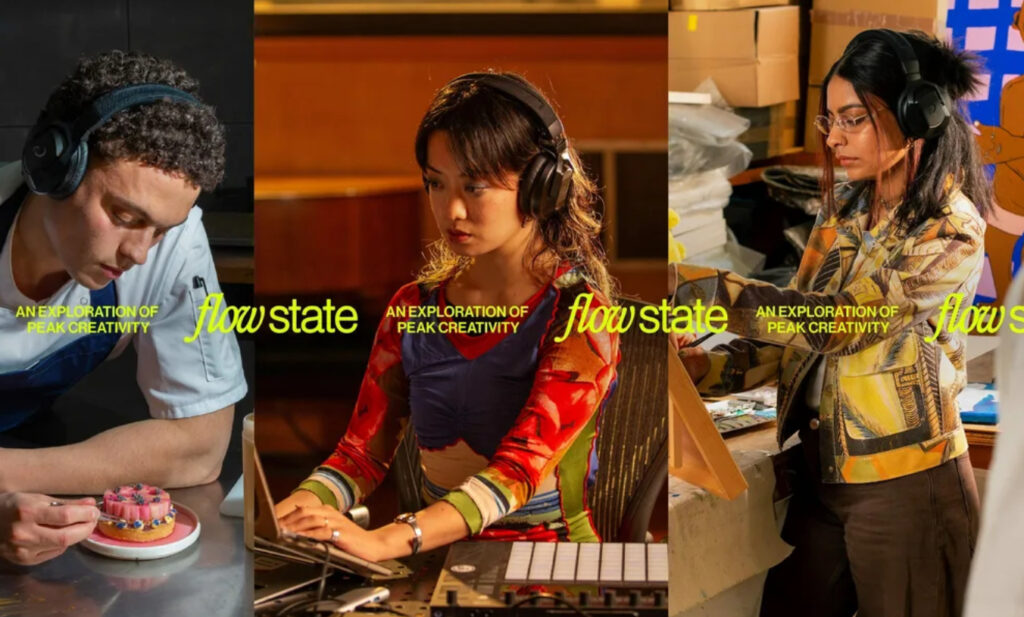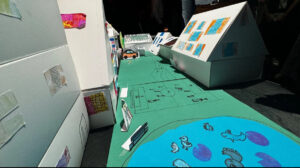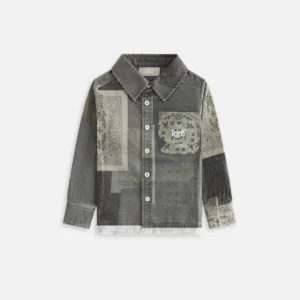There are few phenomena more elusive, more intoxicating, and more coveted in the creative world than the flow state. It is the quiet, transcendent moment when one becomes fully immersed in the task at hand. Time dilates. The outside world blurs. Conscious thought quiets to a whisper. It’s the psychological equivalent of passing through a portal — from chaotic awareness into a purified stream of intention. Artists chase it. Scientists dissect it. Performers live for it. And in collaboration with AlphaTheta, we sat down with three boundary-defying music creatives — anu, Joel Mignott, and object blue — to map the mental terrain of flow and how it shapes their craft, performance, and identity.
The Anatomy of Flow: A Scientific Prelude
Before the beat drops and fingers meet knobs, we must consider what happens in the brain during a flow state. Coined by psychologist Mihaly Csikszentmihalyi in the 1970s, flow is described as a state of optimal experience. Neurologically, it’s marked by a unique neural signature: increased alpha and theta brainwave activity, a temporary suspension of the prefrontal cortex, and a deep synchrony between intention and action. In lay terms, it’s when doing feels like being. It’s when everything — self-doubt, anxiety, external judgment — momentarily dissolves.
AlphaTheta, known for its deeply considered approach to music technology, understands this intangible quality better than most. Their philosophy revolves around creating tools that act less as machines and more like gateways — portals into the musical subconscious. So when they sought to unpack the creative headspaces of modern artists, they turned to three who exemplify the range and fluidity of flow itself.
object blue: Losing the Self in the Circuit
For object blue, the flow state is not just a creative phenomenon — it’s an existential recalibration. The London-based DJ and producer, known for her volatile sonic textures and emotionally charged sets, describes a palpable anxiety that often precedes her live performances. “I get so nervous beforehand. I think a lot about how it’ll go wrong,” she says. “But then I hit play. And if there’s a track with triplets — those patterns always do something to me — the nerves just dissolve.”
Her description is visceral, familiar to anyone who has stepped onto a stage with the weight of expectation hanging overhead. But the moment she locks in, her sense of self begins to blur. “The crowd, the music, the pressure — it all narrows into this tunnel. I can’t hear anything except what I’m doing. And even that feels like it’s doing itself.”
This disassociation — where the performer becomes a vessel — is a hallmark of deep flow. For object blue, the tools she uses are not merely functional, they are communicative. The tactile intimacy of her setup, the physicality of her movements, the responsiveness of the sound — all of it feeds into the feedback loop between thought, body, and audience. The rig doesn’t just channel her creativity; it mirrors it.
anu: Flow as Emotional Cartography
Where object blue dives into the technical and emotional volatility of live performance, DJ and illustrator anu brings a more ambient, narrative perspective. A multi-disciplinary artist whose work spans sound, zines, and visual storytelling, anu sees flow not as a flash of intensity but as a drift — a slow immersion into a world she’s building moment by moment.
“Flow for me feels like falling into a story I didn’t realize I was telling,” she says. “Whether I’m mixing a set or sketching, it’s not about perfection — it’s about curiosity. About following a thread until it takes me somewhere surprising.”
That sense of exploratory creativity requires an open channel between emotion and output. For anu, that channel often opens when the stakes are low and the joy is high — when she’s playing records at home or making collages with no goal in mind. She describes a set she once played to a half-empty room in Berlin where, without the pressure to impress, she slipped into a sublime groove that felt like “playing for just myself, and maybe the floor tiles.”
It’s an important reminder that flow doesn’t always come in high-stakes environments. Sometimes, it arrives in the quiet corners — where permission replaces performance, and the self relaxes into presence. With AlphaTheta’s tech built for customization and emotional responsiveness, artists like anu are free to reconfigure their creative architecture around intuition, rather than instruction.
Joel Mignott: The Dance of Control and Release
Joel Mignott is a genre-defying DJ, selector, and style maverick who threads fashion, emotion, and sound into a singular artistic voice. For him, the flow state begins with intention — but only truly unlocks through surrender. “You need to prepare. You need to know your library, your transitions, your moods,” he says. “But then, at some point, you have to let go of all of it. Let the room lead you.”
That dialogic approach — between self and space, plan and improvisation — defines Mignott’s relationship with music. “I think of it like dancing with the night,” he offers. “You show up dressed, you’ve practiced the steps, but the best moments happen when you’re not thinking at all. When the beat catches you off-guard and suddenly you’re flying.”
What makes Mignott unique is how he pairs this fluid spontaneity with razor-sharp technical mastery. His sets don’t just move — they evolve. A drum loop becomes a sigh, a vocal flips into a memory, a beat drop feels like a confession. AlphaTheta’s gear, which prioritizes precision without rigidity, offers him the ideal platform to dance between prepared narratives and impulsive deviation.
The Role of Tools: Interface as Extension of Mind
Across these perspectives, one theme emerges with crystalline clarity: the tools of music-making are not neutral. They’re active participants in the creative flow. For object blue, a controller’s ergonomics can mean the difference between panic and euphoria. For anu, the openness of a sampler can enable the drift into abstract storytelling. For Joel Mignott, intuitive responsiveness is what allows him to let go of conscious control.
AlphaTheta’s mission has long been to dissolve the boundary between artist and apparatus. Their flagship gear is not about overload — it’s about alignment. Features like tactile jog wheels, dynamic pads, and responsive EQs are not bells and whistles; they’re bridges. They make it possible for the artist’s interior world — murky, emotional, nonlinear — to translate into precise sonic architecture.
In this sense, flow is not just a psychological or neurological event. It’s also a material phenomenon. It emerges from the physical interaction between fingers and sliders, headphones and silence, rhythm and risk.
Flow as Resistance: Reclaiming Presence in a Distracted World
To speak of flow today is also to speak of its rarity. In an age of perpetual distraction, attention has become a form of currency — one constantly demanded and depleted by digital platforms, productivity metrics, and algorithmic noise. In this landscape, the flow state is more than a personal reward. It’s a form of resistance.
Each of these artists touches on this. object blue speaks of battling existential anxiety before her sets. anu mentions how flow only really finds her when she stops trying to prove anything. Mignott calls it “a miracle” when he can lose himself in a room without second-guessing his instincts. In each case, flow is not a given — it’s earned. Or rather, it’s allowed.
To create the conditions for flow, artists must cultivate environments where mistakes are welcome, curiosity is trusted, and intuition isn’t second-guessed. They must build rituals — whether that means sketching before a set, playing a favorite warm-up track, or doing vocal exercises in silence. And they must choose tools that do not distract, but rather dissolve into the background of their focus.
Toward a Flow-Driven Future
It is no accident that AlphaTheta is investing in conversations like this. As creative technologies become increasingly powerful, the challenge is not what they can do, but how they make artists feel. Do they invite presence? Do they amplify expression? Do they disappear when the moment demands full immersion?
In this regard, the collaboration with object blue, anu, and Joel Mignott is not a marketing gesture. It is a manifesto. A recognition that the next frontier of music technology will not be defined by sheer power, but by its capacity to foster presence, play, and vulnerability.
The future of creativity will belong to those who can touch flow — not just occasionally, but as a practice. As a muscle. As a way of life.
When Time Slips: The Final Word
There is something haunting about watching an artist fall into flow. Their eyes glaze with calm concentration. Their body becomes rhythm incarnate. Their choices seem inevitable and spontaneous all at once. Time melts away — not because it ceases to matter, but because it’s been replaced by something truer: a pulse, a feeling, a story being told in real-time.
With AlphaTheta, and with voices like object blue, anu, and Joel Mignott, we glimpse the contours of that story. And in doing so, we are reminded of what it means to really be here. Not online. Not rehearsed. But present. Fully. Deeply. Musically.
No comments yet.







